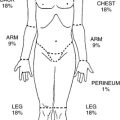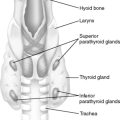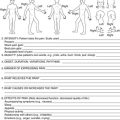CHAPTER 52. Discharge Planning
Extended Observation, Home and Follow-Up Care
Susan Fossum
OBJECTIVES
At the conclusion of this chapter, the reader will be able to:
1. Describe guidelines for extended care and observation.
2. Describe the best times for planning patient discharge.
3. Identify appropriate discharge instructions that should be provided to the patient and family/caregiver.
4. Describe guidelines for discharging the ambulatory surgical patient.
5. List postdischarge follow-up techniques.
I. DISCHARGE PLANNING
A. Definition
1. Discharge plan individualized to meet specific patient needs; involving patient and family as active participants along with interdisciplinary team
a. Ambulatory surgical patient needs
b. Extended care/observation patient needs
c. Patient transferred to long-term care facility
d. Postdischarge follow-up.
2. To ensure safe and efficient discharge process
3. Assessment findings will guide interventions.
4. Ensure implementation of cost containment strategies.
5. Implement measures to improve patient outcomes and satisfaction.
B. Process includes:
1. Identification
2. Assessment
3. Goal setting
4. Planning
5. Coordination
6. Implementation
7. Evaluation
C. Initially takes the form of patient assessment
D. Primary goal for ambulatory patient—in a minimal period, patient will be:
1. Clinically stable, “home ready,” “fit for discharge”
a. Hemodynamically stable
b. Mental status returned to baseline
c. Pain at a manageable level
d. Minimal nausea/vomiting
2. Safely discharged
3. Returned to “preprocedure” level of function
E. Extended observation level of care
1. Admission criteria
a. Clinically stable but needing extended care
b. Awaiting transportation home
c. Patients with no caregiver
d. Patients having procedures requiring extended observation/interventions
(1) Risk for bleeding
(2) Pain management
(3) Postoperative nausea and vomiting
(4) Dizziness
2. Provide follow-up for extended care as indicated.
a. Ongoing assessment and management
b. Medication management
c. Review of discharge instructions as appropriate
d. Safe transfer of care including structured handoff process
3. Extended observation staffing
a. Two competent personnel, one of whom is an RN possessing competence appropriate to the patient population
b. One RN to 3 to 5 patients
c. Additional registered nurse and support staff as dependent on:
(1) Patient acuity
(2) Patient census
(3) Physical facility
F. Discharge planning should begin as soon as possible.
1. Individualized to patient-specific identified needs
a. Cognitive ability
b. Pain assessment
c. Medication history
d. Laboratory and diagnostic testing
e. Cultural and language preferences
f. Advanced directive
2. Starts at the time patient is scheduled for the procedure or hospital admission
3. Discussed at the time of the preadmission visit
a. Comprehensive history is key tool in discharge planning.
b. Type/duration of surgery/anesthesia taken into consideration
c. Available support systems conducive to home management discussed
d. Identification and resolution of physiological home care problems
(1) Fall risk assessment
(2) Physical barriers that impede normal activities of daily living
(a) Ability to shower
(b) Mobility in home environment (stairs, tub, etc.)
(3) Equipment needed (crutches, canes, wheelchair, continuous passive machine, wound vac, etc.)
(4) Supplies needed (dressings, medications, etc.)
4. Review and reinforce plan in preoperative holding unit.
a. Obtain comprehensive nursing history (if not done previously) to include:
(1) Personal coping deficits
(2) Family and community support available
(3) Geographic isolation
(4) Physical limitations
5. Planning discussed in phase II/extended observation with patient/next caregiver before discharge
G. Discharge planning addresses:
1. Safe home environment
2. Availability of responsible adult caregiver
3. Safe transportation home
a. Two responsible persons when transporting infant or child, one to attend to child while other drives vehicle
b. Place child in appropriate-sized car seat or with seat belt.
4. Safe transfer of care to next responsible caregiver
5. Access to medical care after discharge
6. Postsurgical issues: pain management, complications, resuming of daily activities, work, school, etc.
H. Guidelines for discharge of ambulatory surgical patients include:
1. Organizational guidelines
a. The Joint Commission
b. Accreditation Association for Ambulatory Health Care
c. Ambulatory Surgery Center Association
d. American Society of PeriAnesthesia Nurses
e. American Society of Anesthesiologists
f. American College of Surgeons
2. Institutional guidelines
a. Detailed process developed in consultation with and approved by:
(1) Nursing
(2) Anesthesia
(3) Medical Staff
3. Process includes:
a. Protocols
b. Policies
c. Collaborative practices
d. Patient evaluated before discharge
BOX 52-1
DISCHARGE ASSESSMENT CRITERIA
Vital signs (circulation; blood pressure, pulse, respirations, oxygen saturation, temperature)
Comfort level (pain, nausea, oral analgesics)
Surgical site (dressings)
Nourishment
Hydration
Level of consciousness
Activity level (ambulation)
Instructions
Support of responsible adult
Ability to urinate if appropriate
f. Postprocedure follow-up within 24 to 48 hours after discharge
(1) Phone call
(2) Post cards/letters
I. Responsible adult available to:
1. Assist patient with activities of daily living.
2. Ensure patient complies with postoperative instructions.
3. Ensure medications and specific supplies are available.
4. Monitor patient progress.
J. Postoperative and follow-up care instructions provided to patient/next caregiver
1. Reviewed with patient and caregiver
a. Reviewed verbally with written instructions provided for home care
b. Reviewed verbally with structured transfer-of-care handoff for extended observation
c. Nurse validates patient’s and caregiver’s ability to reiterate instructions to ensure that they understand.
d. Interpreter used to ensure appropriate level of understanding when applicable
(1) Give instructions in patient’s native language to ensure understanding.
(2) Discharge instructions should be printed in the patient’s language.
(3) Because of confidentiality, patient’s family member is not a preferred translator.
(4) Ideally, interpreters should be of the same sex as the patient.
(5) Interpreter services may be obtained through ATT Language Line Services (1-800-752-6096) if no other available.
2. Written copy provided
a. Written level of instructions at fifth grade
b. Large print available for visually impaired
c. Instructions available in multiple languages for culturally diverse patient population
d. Emergency contact information provided in writing (physician’s office, clinic, emergency contact numbers)
3. Place copy of instructions in patient medical record.
4. Box 52-2 includes education topics to cover on discharge instruction sheets.
BOX 52-2
EDUCATION POINTS FOR DISCHARGE INSTRUCTIONS
Medications
▪ Note the name, purpose, and dosage schedule for each medication; emphasize the importance of following the directions on the label.
▪ The patient should resume medications taken before surgery per physician’s order.
▪ If pain medication is not prescribed, nonprescription, nonaspirin analgesics (e.g., acetaminophen, ibuprofen) may be effective for mild aches and pains.
▪ Additional pain medication may be ordered by the physician after surgery. The patient should take these medications as directed, preferably with food to prevent gastrointestinal upset.
▪ Nonpharmacological alternative therapies/adjuncts to pain relief (e.g., ice, relaxation techniques)
Activity Restrictions
▪ Advise the patient to take it easy for the remainder of the day after surgery. Dizziness or drowsiness is not unusual following surgery or anesthesia.
▪ Emphasize care to affected limb if regional block performed (e.g., femoral, scalene).
▪ For the next 24 hours, the patient should not:
▪ Drive a vehicle or operate machinery or power tools
▪ Consume alcohol, including beer and wine
▪ Make important personal or business decisions or sign important documents
▪ Activity level: In specific behavioral terms (e.g., do not lift objects heavier than 20 lb), describe any limitation of activities.
Diet
▪ Explain any dietary restrictions or instructions.
▪ If no dietary restriction exists, instruct the patient to progress as tolerated to a regular diet.
Surgical and Anesthesia Side Effects
▪ Anticipated sequelae of surgery (e.g., bleeding and pain) should be delineated.
▪ Common side effects associated with anesthesia include dizziness, drowsiness, myalgia, nausea and vomiting, or sore throat.
Possible Complications and Symptoms
▪ Instruct the patient and responsible adult in pertinent signs and symptoms that could be indicative of postoperative complications.
▪ The patient should call the responsible physician if he or she develops:
▪ Fever >38.3 ° C (101 ° F)
▪ Persistent, atypical pain
▪ Pain not relieved by medication
▪ Bleeding or unexpected drainage from the wound that does not stop
▪ Extreme redness or swelling around the incision site or drainage of pus
▪ Urinary retention
▪ Continual nausea or vomiting
Treatment and Tests
▪ Procedures that the patient or responsible adult is expected to perform (e.g., dressing changes or the application of warm, moist compresses) should be described in detail.
▪ A complete list of necessary supplies should be included.
▪ If any postoperative tests are to be conducted, instructions as to the date, time, test location, and any preop visit preparation should be listed.
Access to Postdischarge Care
▪ Note the telephone number of the responsible and available physician.
▪ Include the telephone number of the ambulatory center and the hours of operation.
▪ Note also the name, address, and the telephone number of the appropriate emergency care facility.
Follow-Up Care
▪ Identify the date, time, and location of the patient’s scheduled return visit to the clinic or surgeon.
From Burden N, Quinn D, O’Brien D, et al (eds): Ambulatory surgical nursing, Philadelphia, 2000, WB Saunders.
5. Document education provided to patient/next caregiver.
6. Postprocedure/discharge follow-up
a. Telephone calls
(1) Sample questions for follow-up phone call (Box 52-3)
BOX 52-3
SAMPLE QUESTIONS FOR FOLLOW-UP PHONE CALL
▪ Do you have any questions?
▪ Do you have any problems relating to your procedure?
▪ Is your pain controlled?
▪ What level of pain are you experiencing (scale of 0-10)?
▪ Have you taken any pain medications? Has it helped?
▪ Do you or have you had any nausea or vomiting?
▪ Did you receive verbal and written instructions?
▪ Did you understand the instructions given?
▪ How did you find your stay on the unit?
▪ How could we improve the service we provide?
▪ Is there anything we could have done to make your stay better?
Allow questions to arise naturally in the conversation and respond accordingly.
Refer to physician if patient has further questions.
b. Written survey
K. Freestanding facilities to have written transfer agreements with nearby hospitals in the event hospitalization for more definitive care or prolonged care becomes necessary
1. Unplanned medical emergencies (cardiac, respiratory, etc.)
2. More extensive surgery required
3. Surgical complications (hemorrhage, dehiscence, etc.)
4. Uncontrolled pain
5. Persistent nausea and vomiting
L. Special needs populations that may require more sophisticated discharge planning (may require extended observation or admission to rehabilitation facility)
1. Elderly patient with limited ability to care for self
2. Patient with significant disabilities and functional impairment
a. Hearing impaired—written and sign language instructions
b. Sight impaired—Braille standardized instructions and audiotapes
3. Patient with advanced malignancy
4. Patient with one or more significant socioeconomic difficulties
a. Homeless
b. History of substance abuse
c. History of violence/abuse in the home
M. Checklist for patient to discuss with health care provider
1. Diet: special dietary restrictions (i.e., diabetic diet)
2. Activities of daily living
a. How soon before ability to resume:
(1) Bathing
(2) Driving
(3) Work/school
(4) Housework/lawn care
(5) Sexual activity
(6) Exercise/rigorous activity
b. Responsible person will be available to assist until normal activities can be resumed.
3. Procedure specific
a. Instructions regarding wound care
b. Specific positioning requirements
4. Pain management
a. Length of time pain is expected to last
b. Medications available
(1) Prescription
(2) Over the counter
c. What to do if medication not effective
d. Alternative therapies
5. Follow-up
a. Postprocedure therapy (physical, occupational, etc.)
b. Next scheduled clinic visit with surgeon
6. Legal considerations
a. Recurrent excuses for not seeking treatment postoperatively because patient did not know:
(1) What to look for
(2) The significance of the symptoms experienced
(3) What to do or whom to contact
b. Medication instructions need to be explicit.
(1) Reasons for noncompliance
(a) Patient did not know when to take the medication.
(b) Patient did not know when not to take the medication.
(c) Patient did not know when to stop taking the medication.
(2) Nurse should reinforce physician’s teachings.
(3) Medication reconciliation forms should be reviewed with patient and family.
7. Emergency contact
a. Under what circumstances physician or nurse should be contacted
b. Emergency contact numbers patient should have
N. Research studies on discharge planning
1. Show mixed results
a. Reduction in hospital length of stay was seen.
b. Reduction in readmission to hospitals
c. Increase in patient satisfaction
d. No evidence that health care costs reduced
2. Discharge planning programs implemented in different ways
BIBLIOGRAPHY
1. Aldrete, J., Modifications to the postanesthesia score for use in ambulatory surgery, J Perianesth Nurs 13 (3) ( 1998) 148–155.
2. American Society of Anesthesiologists, Standards for postanesthesia care. ASA standards, guidelines and statements. ( 2005) ; American Society of Anesthesiologists.
3. American Society of PeriAnesthesia Nurses, Standards of perianesthesia nursing practice 2008–2010. ( 2008)American Society of PeriAnesthesia Nurses, Cherry Hill, NJ.
4. In: (Editors: Burden, N.; Quinn, D.; O’Brien, D.; et al.) Ambulatory surgical nursing ( 2000)WB Saunders, Philadelphia.
5. Dewar, A.; Scott, J.; Muir, J., Telephone follow up for day surgery patients: Patient perceptions and nurses’ experience, J Perianesth Nurs 19 (4) ( 2004) 234–241.
6. Discharge planning for the older adult. National Guideline Clearinghousewww.guideline.gov; John A. Hartford Foundation Institute for Geriatric Nursing.
7. Drain, C.; Odem-Forren, J., PeriAnesthesia nursing: A critical care approach. ed 5 ( 2009)Saunders, St Louis.
8. Mamaril, M., Fast-tracking the postanesthetic patient: The pros and cons, J Perianesth Nurs 15 (2) ( 2000) 89–93.
9. Marley, R.; Moline, B., Patient discharge from the ambulatory setting, J Post Anesth Nurs 11 (1) ( 1996) 39–49.
10. National Alliance for Caregiving, United Hospital Fund of New York, Hospital discharge planning: Helping family caregivers through the process, Available at:www.caregiving.org/pubs/brochures/DischargePlanner.pdf ( 2008); Accessed March 3.
11. WebMD: Surgery: What to expect, Available at:www.webmd.com/a-to-z-guides/surgery-what-to-expect-topic-overview ( 2008); Accessed March 3.





